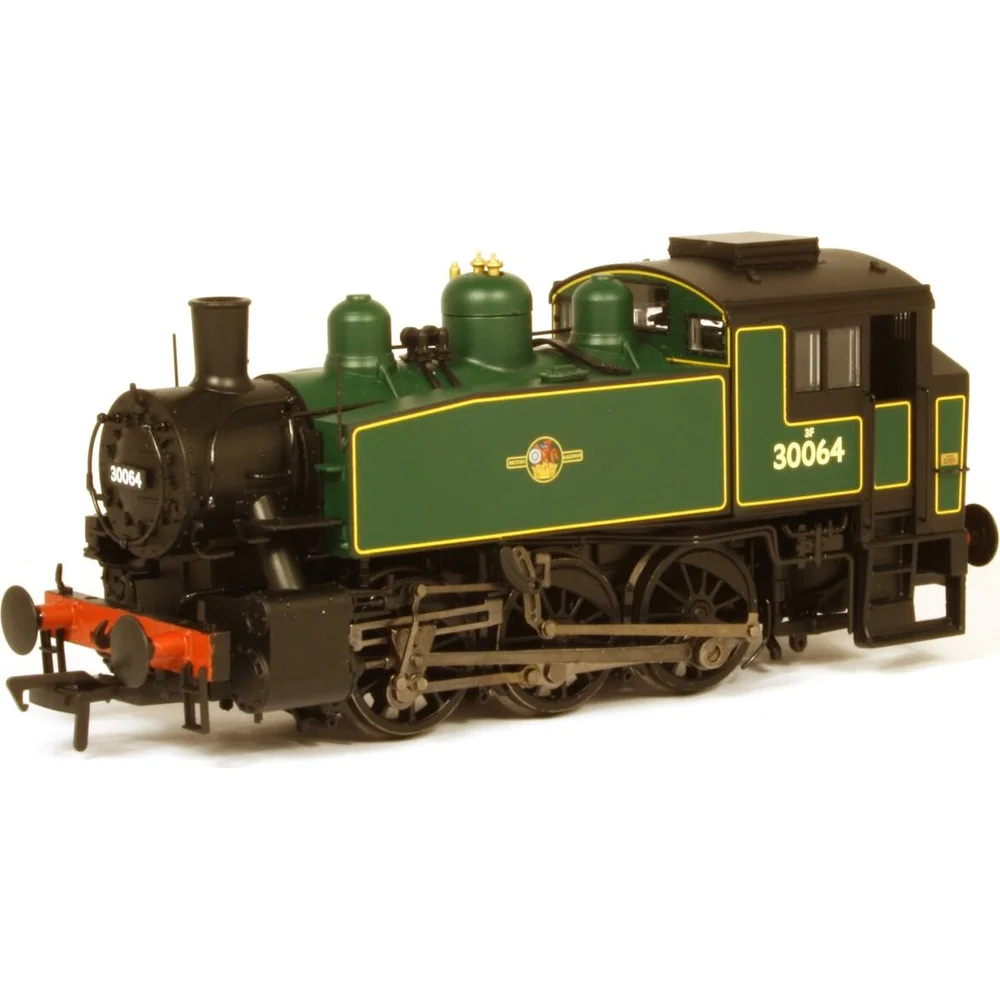Bachmann MR-104A
Southern Railway USA 30064 British Railways SR Malachite Green
Tooling
In 2016, Model Rail Magazine introduced an exclusive ready-to-run model of the Southern Railway “USA” Class 0-6-0T, based on the USATC S100 design. Originally commissioned from Dapol, the project was cancelled and later offered to Bachmann Branchline, who developed entirely new tooling. These locomotives were built during WWII for shunting duties and later adapted by Southern Railway for use at Southampton Docks. Fifteen were purchased post-war, earning the nickname “Yank Tanks.” Several survived into preservation, making them a popular subject for modellers.
Tooling Features
- Scale: OO gauge (1:76.2)
- Construction: Injection-moulded plastic body with fine rivet detail; die-cast metal chassis for weight and stability
- Detailing: Two cab variants (USATC & SR), two smokebox styles, separate wire handrails, turned brass safety valves and whistle, detailed cab interior with glazing, full brake rigging, chemically blackened wheels, correct-thickness rods
- Couplings: NEM pockets with tension-lock couplers; sprung metal buffers
Mechanical & Electrical
- Motor: 5-pole skew-wound can motor with flywheel for smooth running
- Drive: Worm and gear drive to all axles; pickups on all wheels
- Minimum Radius: 2nd radius (438 mm)
- Weighting: Internal chassis weighting for adhesion
- Lighting: None (prototype had no lights)
DCC Capability
DCC Ready with a 6-pin NMRA socket. No factory provision for sound, but aftermarket installation is possible. Any NMRA-compliant decoder can be fitted.
Liveries Produced
The range included USATC black, Southern Railway black, BR black (early and late crest), BR green, Longmoor Military Railway blue, National Coal Board black, and preservation schemes such as Keighley & Worth Valley golden ochre. Two additional variants were released in 2018.
Reviews & Commentary
Reviews praised the model’s exceptional detailing and smooth, slow-speed performance. The mechanism was described as “one of the slowest and smoothest runners straight from the box,” ideal for shunting layouts. Social media and YouTube reviews highlighted the fine cab detail, accurate valve gear, and robust build quality, though some noted fragility due to the level of detail.
Video Reviews
- Sam’s Trains Review – “American Engines Used In Britain? | Bachmann USA Tank” – Unboxing, detail close-ups and running tests.
- Model Rail Exclusive Review – “Limited Edition Bachmann USA 0-6-0T Class” – Focuses on the MR-103 catalogue version, running performance and comparisons.
Interesting Facts
- The tooling was exclusive to Model Rail and not shared with Bachmann’s standard range.
- Initial batch of ten versions sold out quickly; prices ranged from £124.95 to £129.95.
- The project marked one of the first collaborations between a UK magazine and a major manufacturer for a fully tooled RTR locomotive.
Class & Prototype
- Class: Southern Railway USA
- Traction: Steam
- Built: 1942-1943
- Total Built: 382
No prototype found.
Operator & Livery
- Operator: British Railways
- Livery: SR Malachite Green
British Railways transformed Britain's fragmented rail network into a unified national system following nationalisation on 1st January 1948. Created from the "Big Four" companies under the Transport Act 1947, BR operated most of Great Britain's railways until rebranding as British Rail in 1965, managing over 20,000 route miles and inheriting nearly 20,000 locomotives of diverse designs.
The organisation pioneered standardisation through its revolutionary BR Standard locomotive programme (1951-1960), producing 999 advanced steam engines under Robert Riddles' direction. These included the versatile Britannia Pacifics, mighty 9F freight engines, and mixed-traffic classes that incorporated the best features from all predecessor companies. The 1955 Modernisation Plan accelerated diesel and electric traction development, creating fascinating mixed-traction operations.
Notable achievements included establishing unified locomotive classification systems, introducing distinctive corporate liveries, and managing the complex transition from steam to modern traction. BR's six regional structure preserved operational diversity whilst enabling standardisation of practices, signalling, and rolling stock that had eluded private enterprise for over a century.
The BR era represents steam traction's final flowering alongside emerging diesel technology, creating unparalleled locomotive variety. Today, this heritage remains highly popular with railway enthusiasts through extensive preserved fleets, heritage railway operations, and comprehensive model ranges from manufacturers like Hornby, Bachmann, and Dapol, making BR subjects essential for authentic post-war British railway modelling across all scales.
